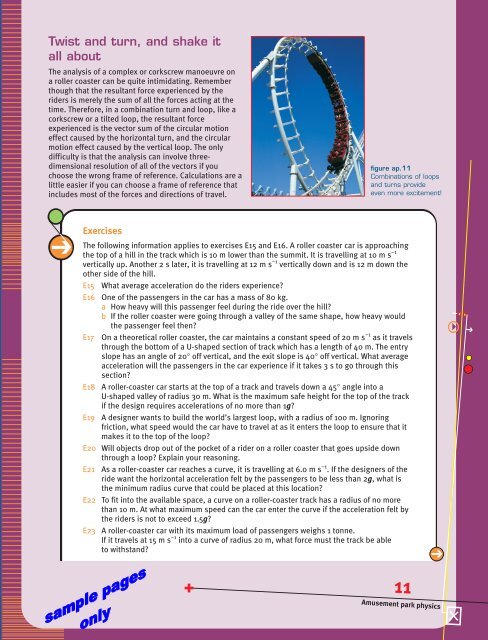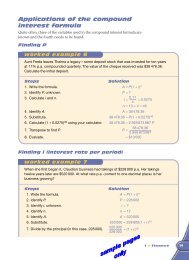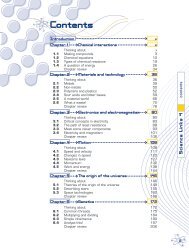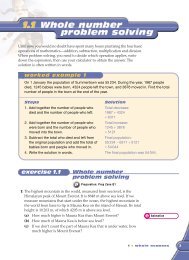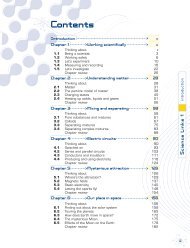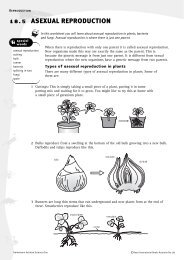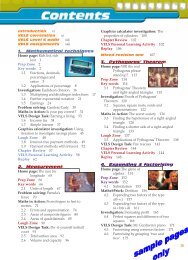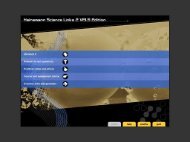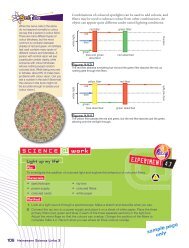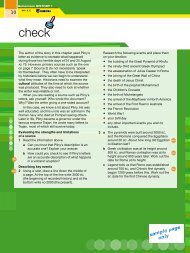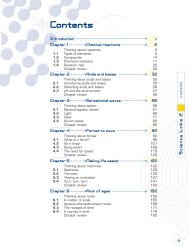Context 1: Amusement Park Physics - hi.com.au
Context 1: Amusement Park Physics - hi.com.au
Context 1: Amusement Park Physics - hi.com.au
Create successful ePaper yourself
Turn your PDF publications into a flip-book with our unique Google optimized e-Paper software.
Twist and turn, and shake it<br />
all about<br />
The analysis of a <strong>com</strong>plex or corkscrew manoeuvre on<br />
aroller coaster can be quite intimidating. Remember<br />
though that the resultant force experienced by the<br />
riders is merely the sum of all the forces acting at the<br />
time. Therefore, in a <strong>com</strong>bination turn and loop, like a<br />
corkscrew or a tilted loop, the resultant force<br />
experienced is the vector sum of the circular motion<br />
effect c<strong>au</strong>sed by the horizontal turn, and the circular<br />
motion effect c<strong>au</strong>sed by the vertical loop. The only<br />
difficulty is that the analysis can involve threedimensional<br />
resolution of all of the vectors if you<br />
choose the wrong frame of reference. Calculations are a<br />
little easier if you can choose a frame of reference that<br />
includes most of the forces and directions of travel.<br />
✚<br />
figure ap.11<br />
Combinations of loops<br />
and turns provide<br />
even more excitement!<br />
➔ Exercises<br />
The following information applies to exercises E15 and E16. A roller coaster car is approac<strong>hi</strong>ng<br />
the top of a <strong>hi</strong>ll in the track w<strong>hi</strong>ch is 10 m lower than the summit. It is travelling at 10 m s –1<br />
vertically up. Another 2 s later, it is travelling at 12 m s –1 vertically down and is 12 m down the<br />
other side of the <strong>hi</strong>ll.<br />
E15 What average acceleration do the riders experience?<br />
E16 One of the passengers in the car has a mass of 80 kg.<br />
a How heavy will t<strong>hi</strong>s passenger feel during the ride over the <strong>hi</strong>ll?<br />
b If the roller coaster were going through a valley of the same shape, how heavy would<br />
the passenger feel then?<br />
E17 On a theoretical roller coaster, the car maintains a constant speed of 20 m s –1 as it travels<br />
through the bottom of a U-shaped section of track w<strong>hi</strong>ch has a length of 40 m. The entry<br />
slope has an angle of 20° off vertical, and the exit slope is 40° off vertical. What average<br />
acceleration will the passengers in the car experience if it takes 3 s to go through t<strong>hi</strong>s<br />
section?<br />
E18 A roller-coaster car starts at the top of a track and travels down a 45° angle into a<br />
U-shaped valley of radius 30 m. What is the maximum safe height for the top of the track<br />
if the design requires accelerations of no more than 1g?<br />
E19 A designer wants to build the world’s largest loop, with a radius of 100 m. Ignoring<br />
friction, what speed would the car have to travel at as it enters the loop to ensure that it<br />
makes itto the top of the loop?<br />
E20 Will objects drop out of the pocket of a rider on a roller coaster that goes upside down<br />
through a loop? Explain your reasoning.<br />
E21 As a roller-coaster car reaches a curve, it is travelling at 6.0 m s –1 . If the designers of the<br />
ride want the horizontal acceleration felt by the passengers to be less than 2g, what is<br />
the minimum radius curve that could be placed at t<strong>hi</strong>s location?<br />
E22 To fit into the available space, a curve on a roller-coaster track has a radius of no more<br />
than 10 m. At what maximum speed can the car enter the curve if the acceleration felt by<br />
the riders is not to exceed 1.5g?<br />
E23 A roller-coaster car with its maximum load of passengers weighs 1 tonne.<br />
If it travels at 15 m s –1 into a curve of radius 20 m, what force must the track be able<br />
to withstand?<br />
11<br />
➔<br />
<strong>Amusement</strong> park physics<br />
<br />
<br />
⌧<br />
➔


